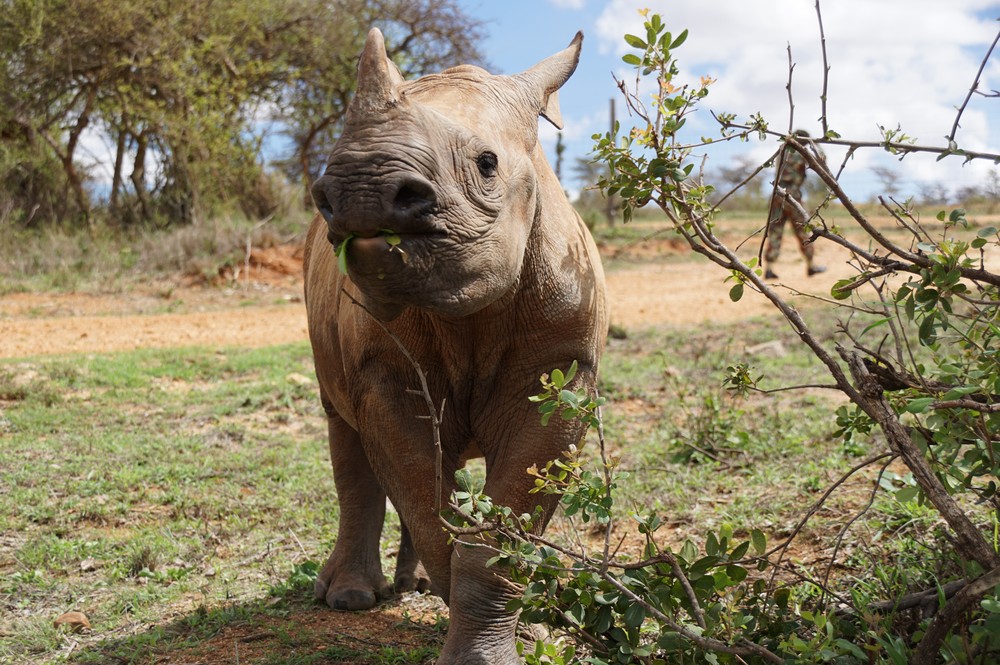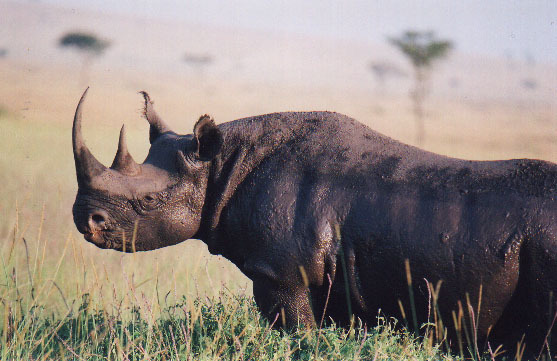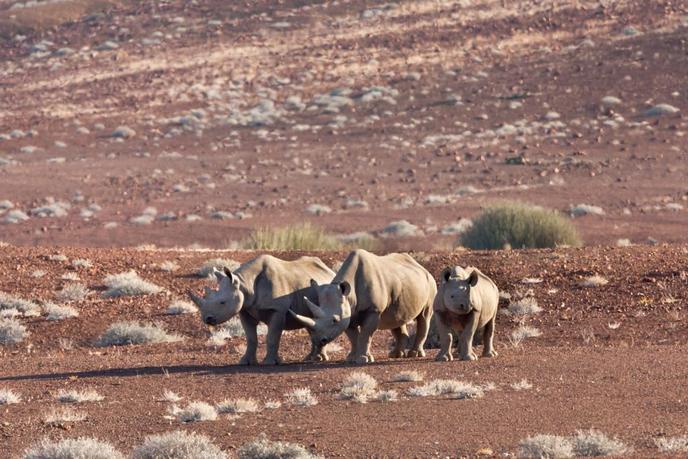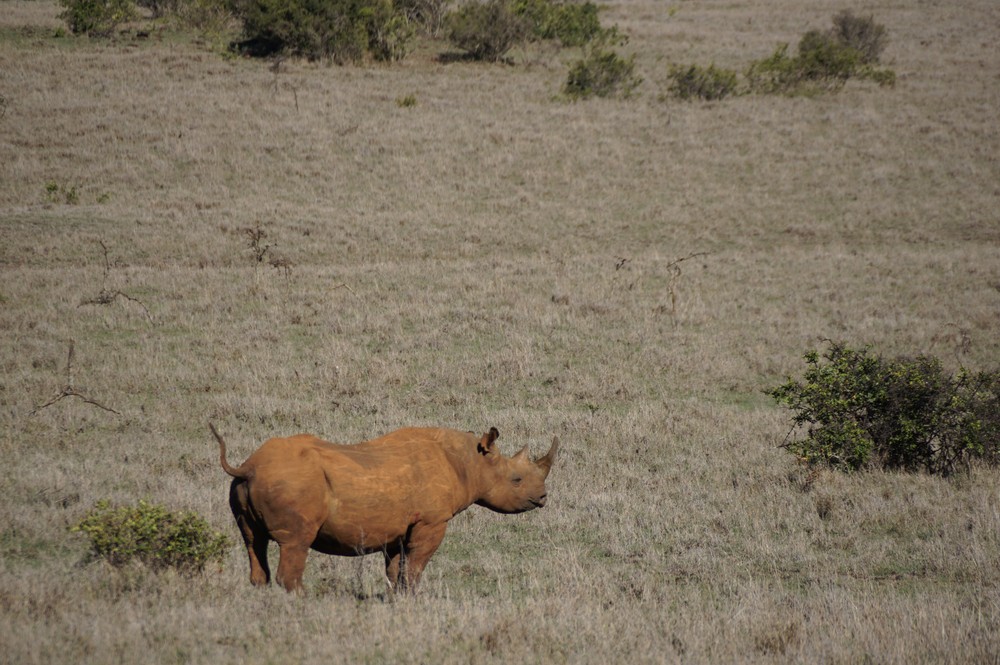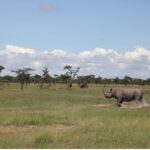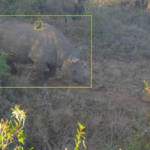Black rhino
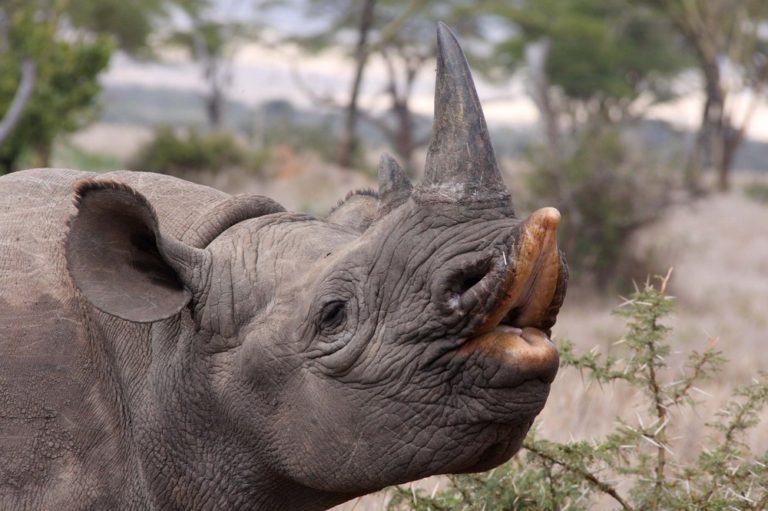
Fun fact
Black rhinos are most active during the night-time, when they do most of their foraging and drinking.
About black rhinos
- Synonym: Hook-lipped rhino
- Scientific name: Diceros bicornis: “Di” meaning “two”, “cerato” meaning “horn” in Greek and “bi” meaning “two”, and “cornis” meaning “horn” in Latin
- Subspecies: There are four subspecies of the black rhino:
Southern Central black rhino Diceros bicornis minor
Eastern black rhino Diceros bicornis michaeli
South Western black rhino Diceros bicornis bicornis
Western black rhino Diceros bicornis longipes (declared extinct in 2011)
Physical characteristics
- Size: the black rhino is the smaller of the two African species
- Weight: adult males weigh up to 1,350 kg and females up to 900 kg. Weight at birth: 35-45 kg
- Shoulder height: black rhinos stand at approximately 1.6 metres tall at the shoulder
- Skin colour: there is actually no colour difference between the white and black rhino. They are both of a dark grey colour, but this can vary depending on local soil conditions (as rhinos tend to wallow in the mud or dust, their skin may vary in colour accordingly)
- Hair: they only have hair on the ears, tail tips and eyelashes
- The horn: black rhinos have two horns, which grow continually from the skin at their base throughout their life (like human fingernails). Rhinos from different areas can have horns of different shapes and sizes also vary. The shape of the horn also differs between sexes: with males tending to have thicker horns, and the females often longer and thinner ones. The horn is comprised of thousands of compressed hair-like strands of keratin (like hair and fingernail fibres), making it extremely hard and tough, but it can be broken or split during fighting. The front (anterior) horn is longer than the rear (posterior) horn, averaging at around 50 cm long
- Distinctive characteristics: black rhinos are smaller than white rhinos, and have less of a pronounced hump on the back of their necks. They also have a smaller head, as unlike the white rhino, they are browsers, so eat from higher bushes or trees, requiring less muscle strength around their necks than white rhinos. The most distinguishable characteristic between a black and a white rhino is that black rhinos have a hooked lip, as opposed to a flat-based lip, which is related to their eating habits
Location and habitat
- Location: black rhino occur throughout southern and eastern Africa, including Kenya, Tanzania, Namibia, South Africa and Zimbabwe
- Habitat: black rhino can occur in a range of habitats where there are sufficient resources to support them. When looking for a new residence, rhinos will tend to look for somewhere with a healthy supply of shrubs and woody herb and plant-life occur, and also a place with a nearby water source and mineral licks, that is within at least a 5-10 mile radius. This spans a wide range of habitats in Africa, including semi-desert savannah, woodlands, forests and wetlands
- Population density within an area: This depends on the features of the habitat in question, from one rhino per 100 km2 in the desert plains of Western Kunene, Namibia to more than one rhino per square kilometre in thicket vegetation
Social behaviour and territory
- Sociability: black rhinos can be either solitary and territorial, or semi-social and less aggressively-territorial, depending on the habitat. Incredible footage from the recent BBC Africa series recorded a group of black rhinos congregating socially at a waterhole, thus disproving myths that black rhinos are strictly solitary
- Male territory: a typical bulls’ territorial range is generally around 3.9-4.7 km. Adult male black rhinos tend to live on their own, except when courting females. Among males, there are dominant and subordinate animals. Subordinate rhino within these ranges are often young adults, who must be submissive to the dominant bull. Young bulls and old males who cannot defend themselves as strongly are often killed or injured in aggressive territorial interactions or become confined to a small area until they die
- Female territory: this tends to range from 5.8-7.7 km. Females tend to remain solitary, and are usually only found in the presence of their latest calf
- Scent-marking: this is a crucial method of communication for rhinos, as they have extremely poor eyesight and often live solitarily. Urine spraying is a common form of scent-marking, both for males seeking to mark their territory, and also for females to signify to nearby bulls when they are in oestrus. Spraying bursts can reach up to a 3-4 metre range, and can be found along feeding and water tracks. Dung piles are also a common scent-mark, known as ‘middens’. Black rhinos may defecate repeatedly in one spot, or distribute dung piles across their home range. Head rubbing is also a form of scent marking: black rhinos leave a distinctive scent against a rock or tree by rubbing a scent gland located on their skin to mark a territory
- Sounds: sniffing and snorting are the most common noises made by rhinos, especially when disturbed. Some grunting between social groups has also been observed as a form of communication
- Daily activity: black rhinos can be active both day and night, but are least active during the hottest parts of the day (around 10am-3pm), where they seek shade under large rocks, trees or mud wallows
Breeding and birth
- Mating and courtship: these are very similar to that of the white rhino; upon sensing that a female is in oestrus, a bull will approach the female, gradually moving closer during the days that she is in oestrus. When the female has accepted his presence, she will cock her tail ready for mating. Copulation usually lasts around half an hour, but pairs may stay together for up to 30 days
- Gestation and birth: females will reach sexual maturity and may have their first calf at 3.5-4 years old. The gestation period of a black rhino is 15-17 months and when a female is preparing to calve, she will find a solitary, sheltered spot to give birth
- Calves: at birth, calves can weigh around 30-45 kg, and can usually stand within the first few hours after being born. They will suckle for the first two months of life, when weaning usually occurs, but may sometimes continue suckling for up to a year. Black rhino calves stay with their mother for 2-4 years before being rejected, usually when the female is ready to calve again. After a newborn calve is around 6-8 months old, a female may allow a previous calf to rejoin her, although these have normally established their own territory by this point
Other interesting facts
- Food: black rhino are browsers (i.e., they eat trees, bushes and shrubs), compared to their cousins, white rhinos, which are grazers. When they bite off woody plant parts they often leave a clean-angled (pruning-shear type) edge (elephant tend to shred the ends of branches like a toothbrush), achieved by the shape of their hooked lip. This neatly bitten, woody material can be clearly seen in the traces of their dung
- Senses: like white rhinos, black rhinos have poor eyesight, and cannot easily detect an observer standing more than 30 metres away. They do however have an excellent sense of smell and hearing
- Footprint: like all rhino species, they have three toes, and thus three stout nails, which leave impressions on the ground to the front and side of a softer wrinkled sole. Their front feet are bigger than the back feet
- Running speed: black rhino can move extremely fast and have been recorded at highs of 55 km/h. They can change direction surprisingly quickly and can run right through scrub and bushes
- Longevity: black rhinos live up to 30-35 years in the wild and 35-45+ years in captivity
- Friendly relations: red and yellow-billed ox-peckers are often seen with rhino and benefit them by removing ticks and clearing parasites from any open wounds, and also by raising the alarm if there is any danger approaching
- Gender ratios: more male calves are born than female calves, but male mortality rate is higher, leading to adult sex ratios biased towards females
Under threat
- Poaching history: during the 19th century, as European influence over land use and trade strengthened, the black rhino, which was the most numerous rhino species with several hundred thousand animals, was hunted relentlessly across most of Africa. By 1970 there were an estimated 65,000 animals left. Today, the black rhino remains a rare sight due to an increase in poaching
- Chinese medicine: poaching pressure escalated during the 1970s and 1980s as a result of the rising demand for rhino horn in Asia and the Middle East. Between 1970 and 1992, the black rhino suffered a 96% reduction in numbers, with total numbers dipping as low as around 2,400
- Current threat: poaching and lack of suitable, safe habitats are the most significant threats


